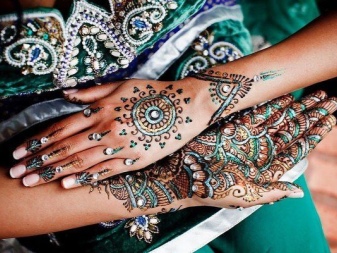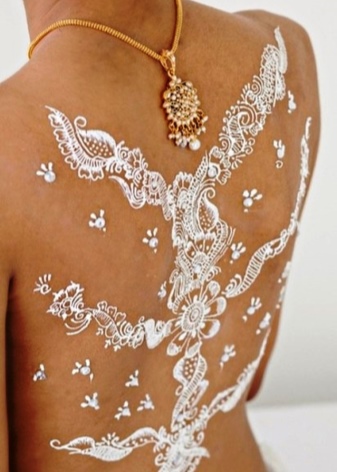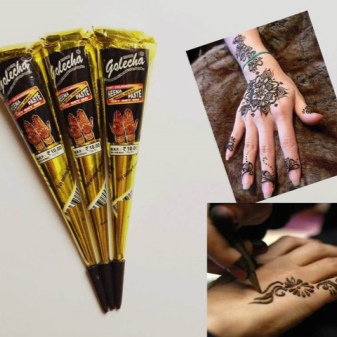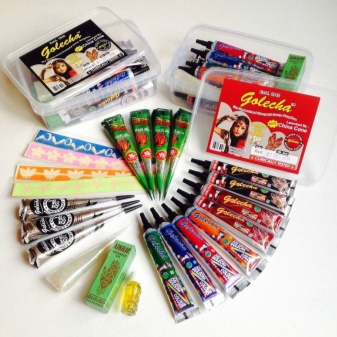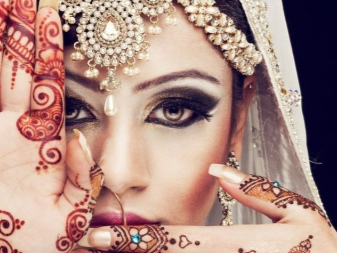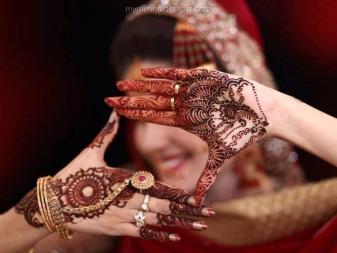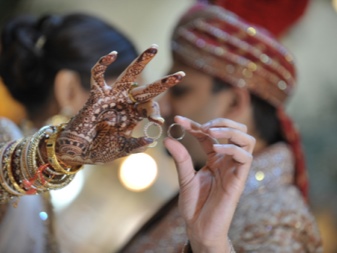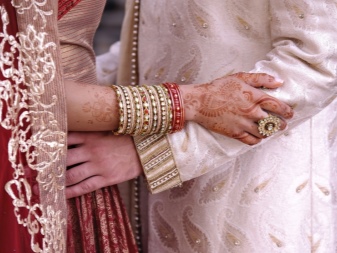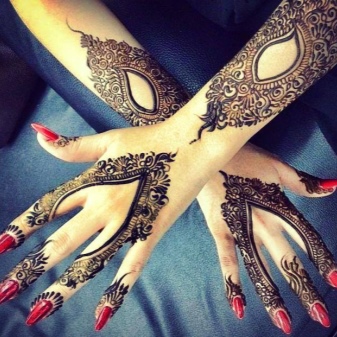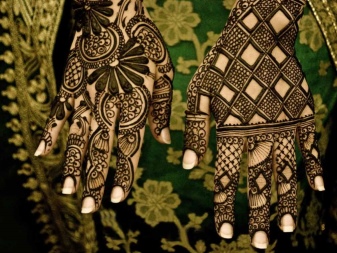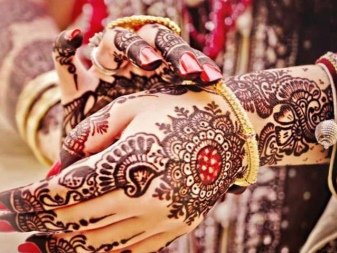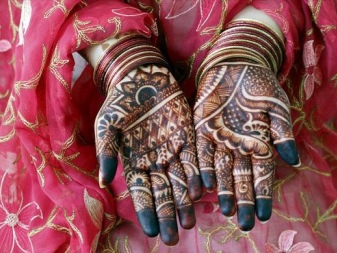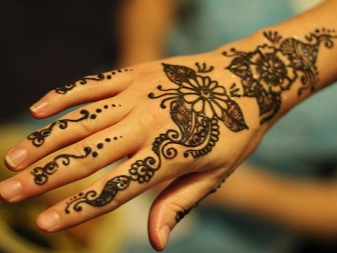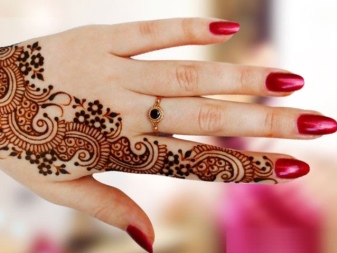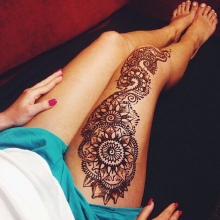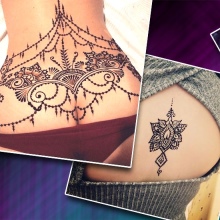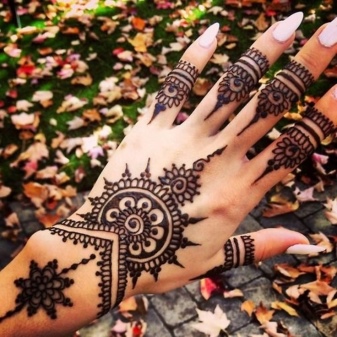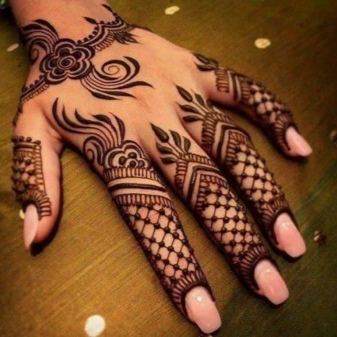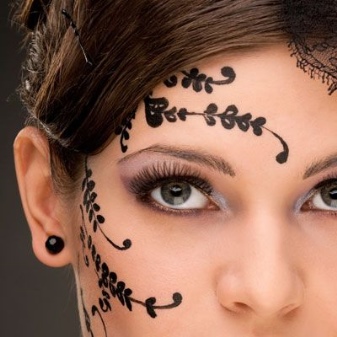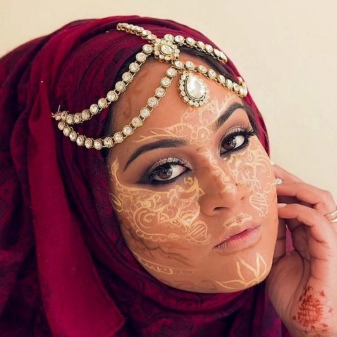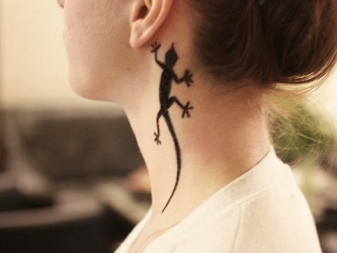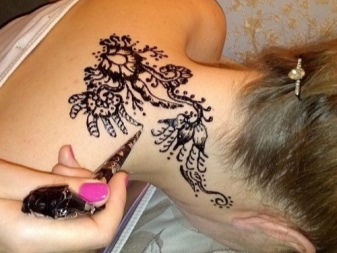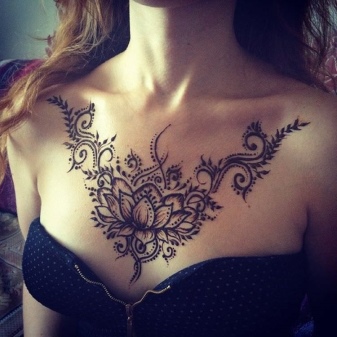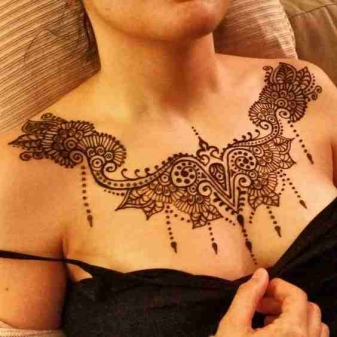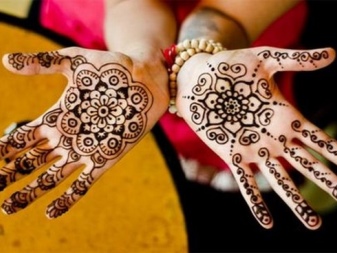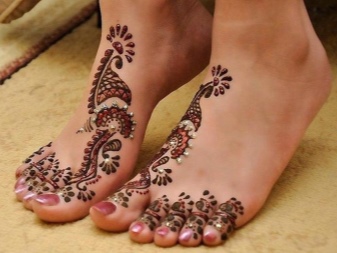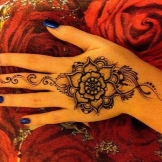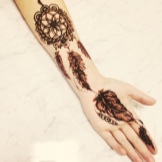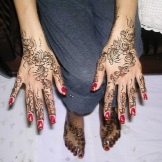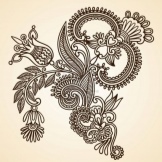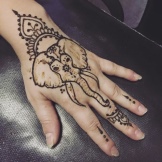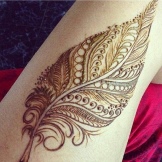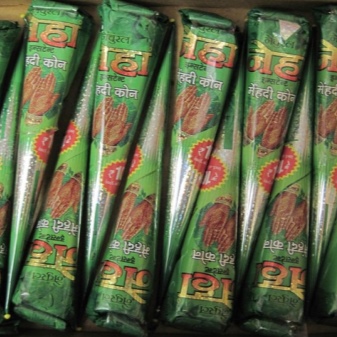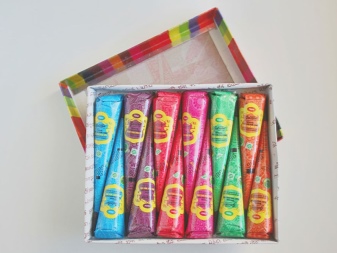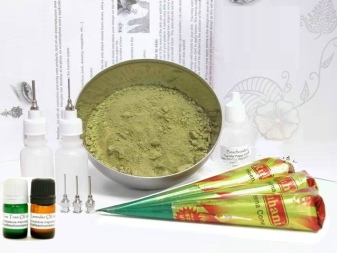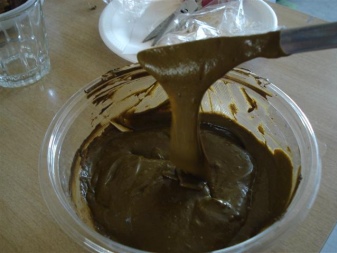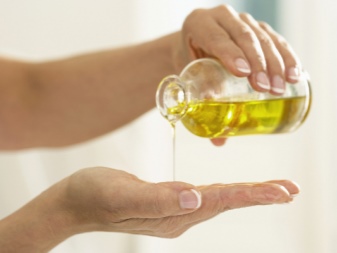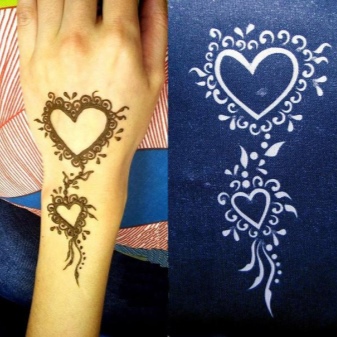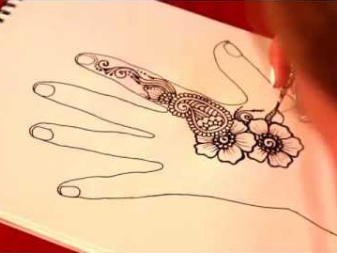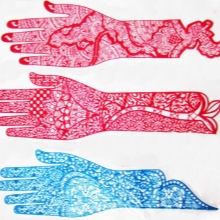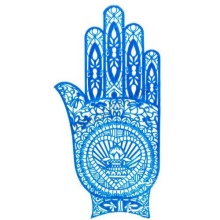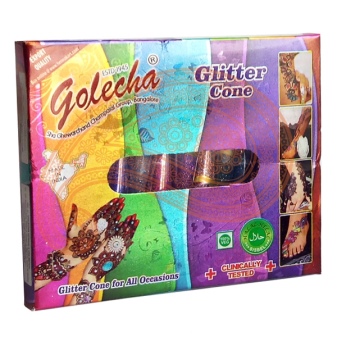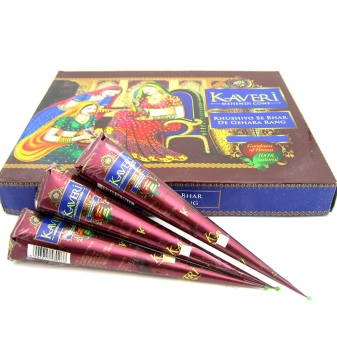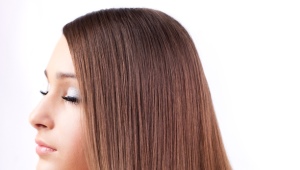Painted henna on the body

Both men and women want a beautiful body. Many of them seek to decorate it, but not everyone can dare to permanent tattoo. After all, the taste can change, but the tattoo will remain. An alternative would be a henna pattern: quick, easy and painless.. You can try to make such a bio-tattoo before applying a permanent tattoo.
What is mehendi?
Henna can be used not only as a tool for dyeing hair and eyebrows. She makes stunning murals on the body, called mehendi. Henna drawing in the modern world is called biota, mehndi, mehandi, mandy.
The story of mehendi begins in ancient Egyptwhere only representatives of high society could decorate their bodies with paintings. After several centuries, patterns of henna migrated to India, where they began to wear a somewhat religious nature and were called "Indian painting". In European countries, mehendi appeared not so long ago, but quickly became popular.
About the story of mehendi can be found in the video:
The technology for creating patterns in all countries is about the same, but there are individual features everywhere.
Oriental beauties know that each drawing is fraught with a certain meaning, so painting with henna should fully correspond to the occasion. Patterns for every day can be simple, but the wedding painting is usually intricate.
The convenience of henna tattoos is that they are made on time and remain on the skin for a maximum of several weeks. The procedure for creating a pattern is absolutely painless and can be held in the cabin (and can be held at home).
How to make mehendi at home, see the following video:
Henna, which is painted, is presented in the form of fine powder. The plant from which it is obtained is called the crib tree. The leaves of the tree are harvested, dried and crushed. The composition is different medical indicators: helps relieve irritation and heal minor wounds. The coloring composition is absolutely harmless, it does not penetrate deep into the tissues, and paints only the surface of the skin. You can decorate with a pattern absolutely any part of your body, everything depends on imagination and the desire to draw.
Pattern styles
Beautiful drawings in each country have their own meaning. Women in European countries with the help of mehendi emphasize their sexuality, give themselves a certain mystery.
Henna drawings of women in Muslim countries (as well as in Africa and India) have a special meaning, ritual and a little magical. Henna patterns are used by beautiful ladies to attract love and wealth in order to protect themselves from evil forces.
Indian brides paint mehendi on hands and body before the wedding. This is done by married women in order to share their experience and share with the bride and groom some secrets of future family life. This ritual is not very fast, it can last for several days. A young wife does not start housework while there is at least one trace of a wedding drawing on her body. This tradition is valid in Muslim countries.
Women make mehndi patterns on their bodies to be more attractive in the eyes of their husband. Due to the medicinal properties of henna, they retain their youth and beauty longer.
The style of the drawing depends on the characteristics of each country, because each nation has its own religious customs, which are reflected in the mehendi. The most common styles are:
- Arab. The main feature of this painting are intricate patterns. Most often, the Arabic style is a floral ornaments and the main features of oriental painting, has no clear application parameters.
- African. This style is very easy to learn, as it is a harmonious blend of geometric shapes and lines. Images should emphasize the lines of the body parts to which they are applied.
- Indian. This is a very complex style. Patterns can be plants, animals and any shapes. Each drawing has a special hidden meaning. Indian technique paint a significant part of the human body.
- Asian. This is a harmonious combination of Arabic and Indian styles. The main nuance of this style is the complete painting of the fingers on the tips.
- European. This is the youngest style of all. It combines all other styles. There is no special meaning in the patterns, as well as the rules of application. What pattern will be applied to the skin, decides directly the person himself, relying on his taste.
Sacred meaning carries in itself not only the pattern, but also the part of the body on which it is applied.
What does positioning on different parts of the body mean?
Painting with henna can be done absolutely on any part of the body.
Many women emphasize their beauty in a similar way. There is no special meaning on where the pattern is located; everything depends only on the desire of the woman.
Modern women make mehendi in the open areas of their bodies: on the face, neck, arms and legs. Women who are going on vacation at sea can make a drawing on the stomach, back, clavicle - and even draw arrows on their eyes with henna.
The fair sex can please their men by making mendy on the chest. By the way, such a choice can give charm, if the mehendi will be viewed through the neckline or in a bathing suit.
The composition of paint for mehendi is completely natural, but some components may cause allergies. Therefore, you should not put the image on the same place more than twice a month.
Consider the most common places for drawing henna.
Mehendi on hand
Hands are chosen more often because they are always visible. Painted hands rivet the eyes of people. You can apply the image on the brush or just on the palm of your hand, or you can paint your arms up to your shoulders.
Images on hands can be any: floral ornaments, intricate oriental motifs, unusual geometric compositions, animals. Mendy in the form of rings on fingers or bracelets on wrists effectively looks.
The location of the biota should also be considered. Henna patterns on the left hand have an impact on human decision making. The most used images on the left are drawings symbolizing luck - for example, an elephant. Mehndi on the right hand reflect the thoughts and desires of the owner.
Biotatu thighs
Such drawings are preferred by women who need to intrigue a man and kindle love ardor in him. Very often there is a lotus, which is a symbol of purity and femininity.
The hip pattern can be represented as a garter. The width of the pattern can be any. If you need to hide mehendi, then you can simply wear a long skirt or pants.
Mehendi on the face
This is a very unusual arrangement of the pattern, which is not just made. Usually the face is decorated for special holidays or parties.
Images on the face are usually small. Figures are selected celestial and divine subjects: stars, crescents and others.
However, it should be remembered that the skin on the face is very delicate. In order to avoid irritation or allergic reaction, you should use natural henna. You must first test for allergies.
Patterns on the neck
They emphasize the ambitiousness of its owner. The image of the lizard symbolizes wisdom, the vine - friendliness. On the neck you can not only depict animals, but also make inscriptions: names or hieroglyphs.
Drawing on chest
This is a very audacious step, a kind of challenge to the commonplace and commonplace. Such mehendi make brave young ladies. Most often animals, lotus or beautiful lace are depicted in the chest area.
Mehndi on the palm
In this case, the drawings are made in African style.On the back are geometric figures that have a special meaning: the square symbolizes stability, the triangle - protection from negative influences, the sun - immortality.
Images on the feet
Female legs always attract attention. There are no restrictions, and each girl can choose the picture to your taste. However, there are nuances in the arrangement of mehendi: the drawing on the right foot symbolizes purposefulness, on the left foot - the search for one’s own way, on the right foot - selfishness of nature, on the left foot - loneliness.
Symbolic meaning of drawings
Henna drawings help to emphasize your individual style, reveal the beauty and characteristics of the character. Someone prefers abstract ornaments, animals are appealing to someone, and flowers to someone. Some drawings may well become a talisman for their owner.
Make a particular pattern is not very difficult. It is more difficult to choose an image that would fully correspond to the internal mood and express the beliefs of the person.
You can see examples of mehendi drawings and choose something for yourself in the following video:
Consider the most common images and the meaning that they conceal:
Flower ornament or individual flowers - most often chosen by representatives of the beautiful half. Such patterns symbolize feminine beauty and tenderness. Rose (as the most frequently chosen flower) means happiness and joy.
Turkish cucumber - is chosen by young girls who dream of getting married. Married women who choose this ornament, seek to attract well-being and prosperity to the family.
Owl - As you might guess, this is a symbol of wisdom. Mehendi with an owl symbolizes the flexibility of the human mind.
Pen - the image symbolizes an extraordinary and bright personality.
Elephant - its value depends on the location of the image. It can attract good fortune, and can mean authority and dignity.
Curved lines - strangely enough, but they can bring good luck in work and career growth.
"Dreamcatcher" - designed to protect people from evil spirits and negative influences.
Crown - such a picture is perfect for those who seek to achieve power and surpass their competitors.
Cat image - means independence, grace and beauty. Most often, this figure is located on the shoulders or legs.
The Dragon - a very ambiguous picture. It is filled with sacred meaning and symbolizes the honor, nobility and strength of its owner.
Skull - a symbol of masculinity and magic. Mehadni with a skull make strong-willed women.
Lotus - means purity and innocence.
Peacock - emphasizes the passion of nature.
Types of Henna
The main ingredient of paint for mehendi is henna.
The saturation of color and durability of the image is directly dependent on its quality. Choosing henna, you should pay attention to its origin and formula.
It comes in the following varieties:
Natural - it has a natural origin. This henna for sale in the form of powder or ready paint of brown color. When purchasing a ready-made product, make sure that its shelf life has not expired. In addition, the brightest color is obtained if henna was made no more than three months ago. The packaging is tapered, making the paint easy to apply to the skin. The texture of the paste should not contain lumps, it should be soft, but not spread.
Colored - in its composition there are chemical components. Paint sold in finished form (in special tubes). Today it sells red, black, henna green and any other color. Mendi, inflicted by a similar composition, looks very similar to tattoos. However, you should consider the fact that chemical additives can cause irritation or lead to allergic reactions. But do not think that paints are available only with chemical composition. There are also a series of colored dyes, the composition of which is as natural as possible.
Color of the image depends on the type of henna and skin tone. It may not turn out completely brown or, for example, orange.
You can buy mehndi paint in special retail outlets with Indian goods, order it on the Internet site or buy it in the salon where they make henna body painting. There you can find not only natural paint, but also color.
How to make a paste for painting with your own hands?
You can make paint at home. To do this, you need to prepare in advance the necessary ingredients, sketches and good mood.
It is not at all necessary to buy paint, you can make it yourself and use it the way you want.
To make the coloring composition, you need to take henna for mehendi or simple henna for coloring hair (but then you need to grind it well), lemon, sugar, coffee, tea brew.
How to prepare paint for mehendi, see the following video.
There is no one recipe for preparing the dye, here are a few of them:
- Squeeze the juice of one lemon and dissolve in it 2 tablespoons of sugar. Then, henna powder (20 g) should be introduced gradually and mixed constantly until a uniform consistency is obtained.
- Brew 100 ml of strong tea, add the juice of half a lemon and 2 tablespoons of sugar. In the resulting mixture, add 20 g of henna and mix until a homogeneous composition.
- Make a cup of coffee and add 3 drops of olive oil, 3 teaspoons of lemon juice, then mix everything thoroughly. In the resulting composition, add 5 tablespoons of henna and mix thoroughly.
The finished composition can not be immediately used for drawing on the body. He needs to stand for a day in a dry dark place. It is advisable to use dishes for cooking pasta, which will not be a pity to throw away, since it will be impossible to wash it.
Home application technology in stages
When the mixture is ready or purchased in advance in the store, you need to properly prepare the skin for drawing: make a peeling and remove hair.
In addition, if you do not know how to draw or do not know which drawing to make, then take ready-made stencils.
Technology to create mehendi:
- Prepare all the necessary drawing tools.
- Change clothes in the right clothes.
- Process skin alcohol, and then - eucalyptus oil.
- Move drawing on the skin with a pencil or fix the stencil.
- Apply Paste from the tube should be a thick layer. If the picture goes beyond the contour, then the excess paint must be removed with a cotton swab.
- Henna dries to 12 hours. The longer the ink remains on the skin, the brighter the pattern will be. From time to time you should sprinkle the skin with lemon juice.
- Dried paint should be removed with a wooden stick.
- Picture process eucalyptus oil.
- Protect the skin from moisture for 4 hours.
You can see the technology of applying mehendi at home in the following video:
How to properly care for a tattoo?
Mehendi lasts from one to four weeks. It depends on the type of henna, the professionalism of the performer and the implementation of the rules for care. To make the picture longer to please you with its color, you should take care of it:
- Apply daily on the pattern of natural oil.
- Before water treatments oil should also be applied.
- Do not rub the pattern washcloth or scrub.
- Do not visit the bath and avoid contact with very hot water.
- Whenever possible leave the body part with the pattern open.
- Lower physical activity.
- Do not hair removal on the spot where the drawing is located.
Mehendi can not be removed, the picture itself will disappear for some time.
Popular drawing ideas
The procedure for painting henna on the skin is best done in a warm room.
If you are doing the drawing yourself for the first time, it is better to pre-apply the contour to the skin. You can prepare sketches and work on them.
For the first time, a simple picture will do.: simple geometric figure, small flower.The entire final pattern can consist of curves and straight lines, points can be additionally applied as decoration.
Pictures with natural ornaments will look more spectacular if you additionally apply several lines.
When the hand is already full, then it will be possible to start creating more complex images.
You can practice a little drawing with henna on paper. To do this, draw an image and gently circle it with paint. First you need to draw straight lines, and then go to the more difficult parts. If you choose a pattern that is made of repetitive elements, then after a workout, you can start painting the skin.
Another alternative would be sketches. Attach to the body and calmly apply the paint from the cone. The main thing - to sketch all the voids. It is necessary to ensure that the stencil fits snugly to the skin (and that nothing falls under it). When the paint is a little dry, gently remove the stencil. The advantage of this application is the reusability of stencils.
Reviews
Many women have already tried to decorate their body with a picture. Almost all of them noted that the greatest difficulty in applying mehendi was to wait for the complete drying of the coloring composition.
As a rule, women preferred to go to salons to get a temporary tattoo. They believe that a picture made by a professional will look better and last longer.
Professional mehendi - in the next video.
Some girls shared their impressions of their first experience with henna.
Some of them said that it is better to buy paint in stores than to do it yourself, otherwise the consistency is not quite suitable. Shopping paste better lay on the skin, quickly set and gave a more saturated color.
The most important nuance, in the opinion of women, was the implementation of proper care for an already applied pattern. The hardest thing was to reduce the number of water treatments.
Some of the young ladies were somewhat upset that the color of the picture was not as saturated as they were supposed to be. However, everyone was satisfied with the result.
Mehndi is a great opportunity to express yourself from an unusual side, show your personality and attract the attention of friends and colleagues.
If initially henna drawings were an integral part of the culture of some countries, then today absolutely any woman of fashion can afford to make such a picture. Modern women do not attach much importance to the meaning of the picture, their beauty is more important to them. The great advantage of mehendi is that the procedure is safe, does not cause allergies. This is a good option if you do not want to do a permanent tattoo. Some women believe that henna drawings can bring good luck and protect against evil.
